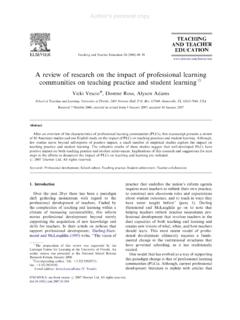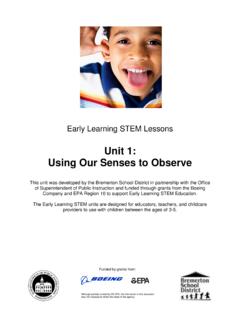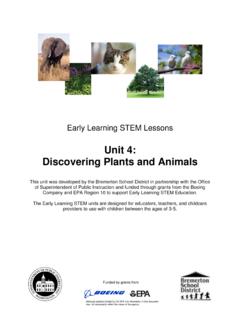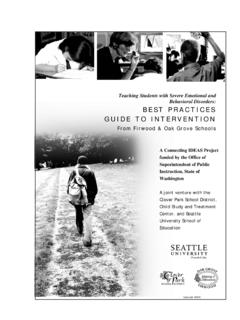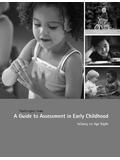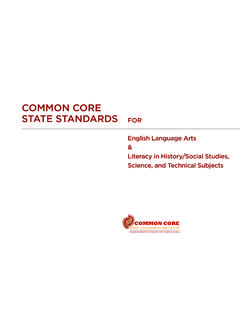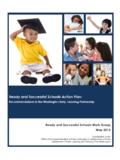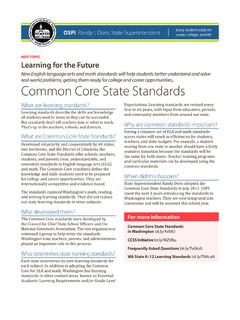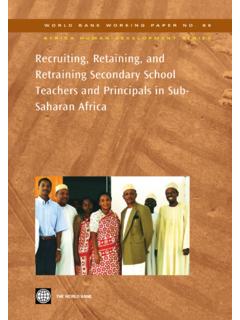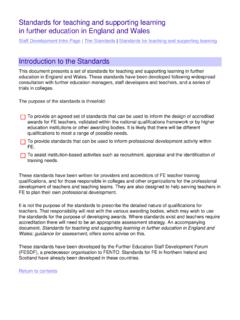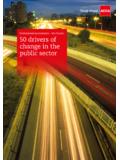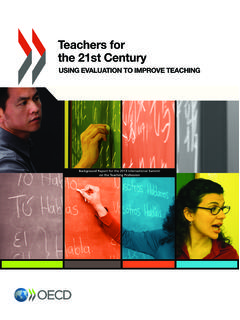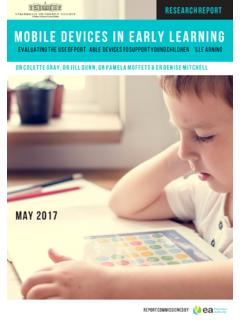Transcription of Teaching and Learning Mathematics
1 Dr. Terry BergesonState Superintendent ofPublic InstructionUsing Research to Shift From the Yesterday Mind to the Tomorrow MindTeaching andLearningMathematicsMarch 2000 Teaching and Learning MathematicsUsing Research to Shift From the Yesterday Mind to the Tomorrow MindDr. Terry BergesonState Superintendent of Public InstructionRosemary FittonAssistant SuperintendentAssessment, Research, and CurriculumPete BylsmaDirector, Research and EvaluationBeverly Neitzel and Mary Ann StineMathematics SpecialistsThe Office of Superintendent of Public Instruction complies with all federal andstate rules and regulations and does not discriminate on the basis of race, color,national origin, sex, disability, age, or marital 2000 About the AuthorThis document was written by Dr. Jerry Johnson, Professor of Mathematics atWestern Washington University in Bellingham. He has a from AugsburgCollege, a from California Institute of Technology, a from theUniversity of California, Los Angeles, and a from the University ofWashington.
2 Dr. Johnson began Teaching at WWU in 1984 and currently teachesclasses in both Mathematics and Mathematics education. He is also part of theWWU faculty team working toward the integration of science, Mathematics , andtechnology curricula. He can be reached by e-mail at This DocumentThis document can be found on our Web site ( ). A free copy ofthis document can be obtained by placing an order on the website, by writing theResource Center, Office of Superintendent of Public Instruction, PO Box 47200,Olympia, WA 98504-7200, or by calling the Resource Center toll-free at (888) 595-3276. If requesting more than one copy, contact the Resource Center to determinethe printing and shipping document is available in alternative format upon request. Contact theResource Center at (888) 595-3276, TTY (360) 664-3631, or contents of this document can be reproduced without permission. Referenceto this document would be appreciated.
3 Funding for this project was provided bythe Excellence in Mathematics Initiative, a state-funded program supportingmathematics education. For questions regarding the content of this document,call (360) staff at the Office of Superintendent of Public Instruction helped preparethis document for publication. Pete Bylsma, Beverly Neitzel, and Mary Ann Stinereviewed the draft document and provided other assistance. Lisa Ireland andTheresa Ellsworth provided editing 1 Introduction 1 Chapter 2 Overview of the Research: A Washington State Perspective 5 Number SenseNumber and Numeration 5 Computation 9 Estimation13 MeasurementAttributes and Dimensions15 Approximation and Precision17 Systems and Tools18 Geometry SenseShape and Dimension18 Relationships and Transformations19 Probability and StatisticsChance21 Data Analysis22 Prediction and Inference23 Algebraic SenseRelations and Representations26 Operations28 Problem Solving30 Communication33 Mathematical Reasoning35 Connections37 Chapter 3 Mathematics in the Classroom.
4 What Research Tells Educators39 Constructivism and Its Use39 Role and Impact of Using Manipulatives40 How Students Solve Word Problems Involving Mathematics43 Mastery of Basic Facts and Algorithms47 Use and Impact of Computing Technologies49 Culture of the Mathematics Classroom52 Impact of Ability Grouping55 Individual Differences and Equity Issues56 teacher Attitudes and Student Attitudes57 Using Performance-Based Assessment61 Chapter 4 Other Research and Issues64 professional development Programs for Mathematics Teachers64 Changes in How Teachers Teach Math and How Students Learn Math68 Next Steps: Using Research as Educators69 Step 1: Mathematics Teachers Accepting Responsibility for Change69 Step 2: The Reeducation of Mathematics Teachers 70 Step 3: Mathematics Teachers in Their New Roles as Researchers70 Appendix AFurther Explorations73 Appendix BList of References75 Index101 AbbreviationsEALRsEssential Academic Learning RequirementsWASLW ashington Assessment of Student LearningTeaching and Learning Mathematics1 Chapter 1 INTRODUCTIONW elcome!
5 In as friendly and useful manner as possible, our goal is to provide aresearch-based overview of the potential and challenges of Teaching qualitymathematics (K 12). Though the primary contexts are the Washington State essentialacademic Learning requirements (EALRs) in Mathematics and the correlatedWashington Assessment of Student Learning (WASL), each reader must interpret andreflect on the content within his/her own district or classroom situation. Without thisimportant step toward interpretation and reflection by each reader, this publicationbecomes yet one more resource to be piled on a shelf for reading on that rainy day thatnever seems to come in are fully aware of the ominous nature of the word research and its associatedbaggage. The mere inclusion of the word in the title of articles or workshop offeringsoften causes teachers and administrators to look for an escape route, whether it isphysical or mental.
6 Yet, our intent is to counter this attitude by constructing aresearch-based perspective that helps both teachers and administrators further themathematics education reform efforts in Washington at all grade levels. As CharlesKettering, an American engineer and inventor (1876 1958), once said:Research is a high-hat word that scares a lot of people. It needn t. It is rather , research is nothing but a state of mind a friendly, welcoming attitudetoward change .. going out to look for change instead of waiting for it to come. is an effort to do things better and not to be caught asleep at the It is theproblem solving mind as contrasted with the let-well-enough-alone It is the tomorrow mind instead of the yesterday Kettering s words, we pull the guiding theme for this book: to use research-basedinformation to support the necessary shift from a yesterday mind to a tomorrow mind in the making of the many decisions as to how Mathematics is taught or learnedin introductory road map through this text can be useful, especially for thosereadersreluctant to make the trip.
7 First, we discuss what research in Mathematics education can and cannot section is important because it helps orient the tomorrow mind in apositive direction while also ensuring that teachers and administrators areaware of potential misuses of 1 IntroductionTeaching and Learning Mathematics2 Second, we overview some of the research results related to each of the essentiallearning academic requirements in Mathematics . The key word here is some, as the volume of research available in Mathematics education is quite large andvaried (in both quality and applicability). Though an attempt was made to sortthrough and select research results in a fair manner, the goal of supporting the tomorrow mind was always in full view. If we omitted mention of researchresults that you have found useful, we apologize for their omission and suggestthat you share them with your colleagues. Also, some of the research resultsmentioned may seem dated but was included because it contributes in somefashion to our current situation and concerns.
8 Third, we address specific questions in Mathematics education as raised byteachers, administrators, or parents. These questions range from the classroomuse of calculators or manipulatives, to the role of drill and algorithmic practice,to the best models for the professional development of teachers. In mostinstances, the research evidence is not sufficient to answer the questions raisedin a definitive manner. We suggest that even small insights or understandingsare better than Teaching in the dark. And fourth, we outline a plan that a teacher , district, or state can follow tomaintain relevancy relative to this document and the issues it addresses. Thatis, the text should be viewed as another small step forward for WashingtonState teachers and administrators. Combined with the other efforts of the Officeof Superintendent of Public Instruction (OSPI), districts, administrators,teachers, and professional groups, these steps forward help us both gain andmaintain momentum in adopting the tomorrow mind in that road map, we ask you to now join us on this trip through the field ofmathematics education research and hope that you find the journey useful.
9 As ourultimate goal is to support teachers and administrators in their efforts to improvestudent Learning in Mathematics , we know that an increased awareness of researchresults is an important form of support. Our apologies are offered if we have eithermisrepresented or misinterpreted the research results as reported. Also, we apologizein advance for any misleading interpretations or summaries of the research conclusionsof others; these lapses were not IN Mathematics EDUCATION: WHAT IT CANAND CANNOT DOThink of the many things that can be investigated in Mathematics education; it is easyto be overwhelmed. Four key ingredients can be identified: The students trying to learn Mathematics their maturity, their intellectualability, their past experiences and performances in Mathematics , their preferredlearning styles, their attitude toward Mathematics , and their social adjustment. The teachers trying to teach Mathematics their own understanding ofmathematics, their beliefs relative to both Mathematics itself and how it isChapter 1 IntroductionTeaching and Learning Mathematics3learned, their preferred styles of instruction and interaction with students, theirviews on the role of assessment, their professionalism, and their effectiveness asa teacher of Mathematics The content of Mathematics and its organization into a curriculum itsdifficulty level, its scope and position in possible sequences, its requiredprerequisite knowledge, and its separation into skills, concepts, and contextualapplications.
10 The pedagogical models for presenting and experiencing this mathematicalcontent the use of optimal instructional techniques, the design of instructionalmaterials, the use of multimedia and computing technologies, the use ofmanipulatives, the use of classroom grouping schemes, the influences oflearning psychology, teacher requirements, the role of parents and significantothers, and the integration of alternative assessment of these ingredients, and their interactions, need to be investigated by carefulresearch. Again, it is easy to be overwhelmed (Begle and Gibb, 1980).Our position is that educational research cannot take into account all of thesevariables. The result we must live with is acceptance that educational research cannotanswer definitively all of the questions we might ask about Mathematics education. Atbest, we can expect research in Mathematics education to be helpful in these ways: It can inform us ( , about new pedagogical or assessment techniques).
